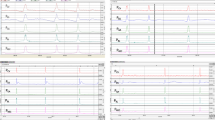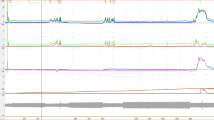Abstract
Background
In patients undergoing a variety of procedures, surgical success is in part dependent on maintaining normal intra-abdominal pressure in the immediate postoperative period. Our objective was to quantify intragastric and intravesicular pressures during activities, through the use of manometry catheters.
Methods
Ten healthy volunteers had a manometry catheter placed transnasally, and a urinary Foley catheter placed. Baseline intragastric and intravesicular pressures were recorded and the catheters were then transduced continuously. Pressures were recorded with activity: coughing, lifting weights, retching (dry heaving), and vomiting.
Results
All pressure changes were significant from baseline except for weight lifting. The highest intragastric pressure was 290 mmHg, seen during vomiting. Comparison of intragastric and intravesicular pressures showed no significant difference. There was significantly higher intragastric pressure with vomiting and retching as compared with coughing, whereas coughing applied more pressure than weight lifting.
Conclusions
This is the first report of intragastric pressures during vomiting and retching (dry heaving). We conclude that vomiting and retching (dry heaving) can render significant forces on any tissue apposition within the stomach or the peritoneal cavity.

Similar content being viewed by others
References
Iqbal A, Kakarlapudi GV, Awad ZT, Haynatzki G, Turaga KK, Karu A, Fritz K, Haider M, Mittal SK, Filipi CJ (2006) Assessment of diaphragmatic stressors as risk factors for symptomatic failure of laparoscopic Nissen fundoplication. J Gastrointest Surg. 10(1):12–21
Schein M, Wittmann DH, Aprahamian CC, Condon RE (1995) The abdominal compartment syndrome the physiological and clinical consequences of elevated intra-abdominal pressure. J Am Coll Surg 180:745–753
Fusco MA, Martin RS, MC Chang (2001) Estimation of intra-abdominal pressure by bladder pressure measurement validity and methodology. J Trauma 50:297–302
Iberti TJ, Lieber CE, Benjamin E (1989) Determination of intra-abdominal pressure using a transurtethral bladder catheter: clinical validation of the technique. Anesthesiology 70(1):47–50
Gudmundsson FF, Viste A, Gislason H, Svanes K (2002) Comparison of different methods for measuring intra-abdominal pressure. Intensive Care 28(4):389–391
Sugrue M, Buist MD, Lanchez LA, Sanchez DJ, Hillman KM (1994) Intra-abdominal pressure measurement using a modified nasogastric tube: description and validation of a new technique. Intensive Care Med 20(8):588–590
Collee GG, Lomax DM, Ferguson C, Hanson GC (1993) Bedside measurement of intra-abdominal pressure (IAP) via an indwelling naso-gastric tube: clinical validation of the technique. Intensive Care Med 19(8):478–480
Mayberry JC, Goldman RK, Mullins RJ, Brand DM, Crass RA, Trunkey DD (1999) Surveyed opinion of American trauma surgeons on the prevention of the abdominal compartment syndrome. J Trauma 47:509–513
Overholt RH (1931) Intraperitoneal pressure. Arch Surg 22:691
Iberti TJ, Kelly KM, Gentili DR, Hirsch S, Benjamin E (1987) A simple technique to accurately determine intra-abdominal pressure. Crit Care Med 15:1140–1142
Kashtan J, Green JF, Parsons EQ, Holcroft JW (1981) Hemodynamic effect of increased abdominal pressure. J Surg Res 30:249–255
Junge K, Klinge U, Prescher A, Giboni P, Niewiera M, Schumpelick V (2001) Elasticity of the anterior abdominal wall and impact for reparation of incisional hernias using mesh implants. Hernia 5:113–118
Heniford BT, Park A, Ramshaw BJ, Voeller G (2003) Laparoscopic repair of ventral hernias nine years’ experience with 850 consecutive hernias. Ann Surg 238:399–400
Burger JW, Luijendijk RW, Hop WC, Halm JA, Verdaasdonk EG, Jeekel J (2004) Long-term follow-up of a randomized controlled trial of suture versus mesh repair of incisional hernia. Ann Surg 240:583–585
Luijendijk RW, Hop WC, van den Tol MP, de Lange DC, Braaksma MM, IJzermans JN, Boelhouwer RU, de Vries BC, Salu MK, Wereldsma JC, Bruijninckx CM, Jeekel J (2000) A comparison of suture repair with mesh repair for incisional hernia. N Engl J Med 343:392–398
Klinge U, Conze J, Klosterhalfen B, Limberg W, Obolenski B, Ottinger AP, Schumpelick V (1996) Changes in abdominal wall mechanics after mesh implantation. Experimental changes in mesh stability. Langenbecks Arch Chir 381:323–332
Ramshaw B, Abiad F, Voeller G, Wilson R, Mason E (2003) Polyester (Parietex) mesh for total extraperitoneal laparoscopic inguinal hernia repair initial experience in the United States. Surg Endosc 17:498–501
Klinge U, Klosterhalfen B, Conze J, Limberg W, Obolenski B, Ottinger AP, Schumpelick V (1998) Modified mesh for hernia repair that is adapted to the physiology of the abdominal wall. Eur J Surg 164:951–960
Oyogoa S, Komenaka I, Wise L (2000) Vertical banded gastroplasty staple-line dehiscence after blunt trauma to the abdomen. Obes Surg 10(1):61–63
Kalfarentzos F, Kechagias I, Soulikia K, Loukidi A, Mead N (2001) Weight loss following vertical banded gastroplasty: intermediate results of a prospective study. Obes Surg 11(3):265–270
Ikeda K, Fritscher-Ravens A, Mosse C, Mills T, Tajiri H, Swain CP (2005) Endoscopic full-thickness resection with sutured closure in a porcine model. Gastrointest-Endosc 62(1):122–129
Mairiaux P, MalchaireJ Vandiepenbeeck D, Bellelahom L (1988) Reproducibility of intra-abdominal pressure when lifting. Scand J Rehabil Med 20(2):83–88
Cobb WS, Burns JM, Kercher KW, Matthews BD, James Norton H, Todd Heniford B (2005) Normal intraabdominal pressure in healthy adults. J Surg Res 129(2):231–235
Acknowledgments
The authors would like to thank Sue Corkell, R.N., our volunteers, and all the staff at the Esophageal Center at Creighton University School of Medicine for their help in obtaining and quantifying the data presented.
Grant support: Ethicon Endo-Surgery, 4545 Creek Road, Cincinnati, Ohio 45242-7000, USA.
Author information
Authors and Affiliations
Corresponding author
Rights and permissions
About this article
Cite this article
Iqbal, A., Haider, M., Stadlhuber, R.J. et al. A study of intragastric and intravesicular pressure changes during rest, coughing, weight lifting, retching, and vomiting. Surg Endosc 22, 2571–2575 (2008). https://doi.org/10.1007/s00464-008-0080-0
Received:
Revised:
Accepted:
Published:
Issue Date:
DOI: https://doi.org/10.1007/s00464-008-0080-0




